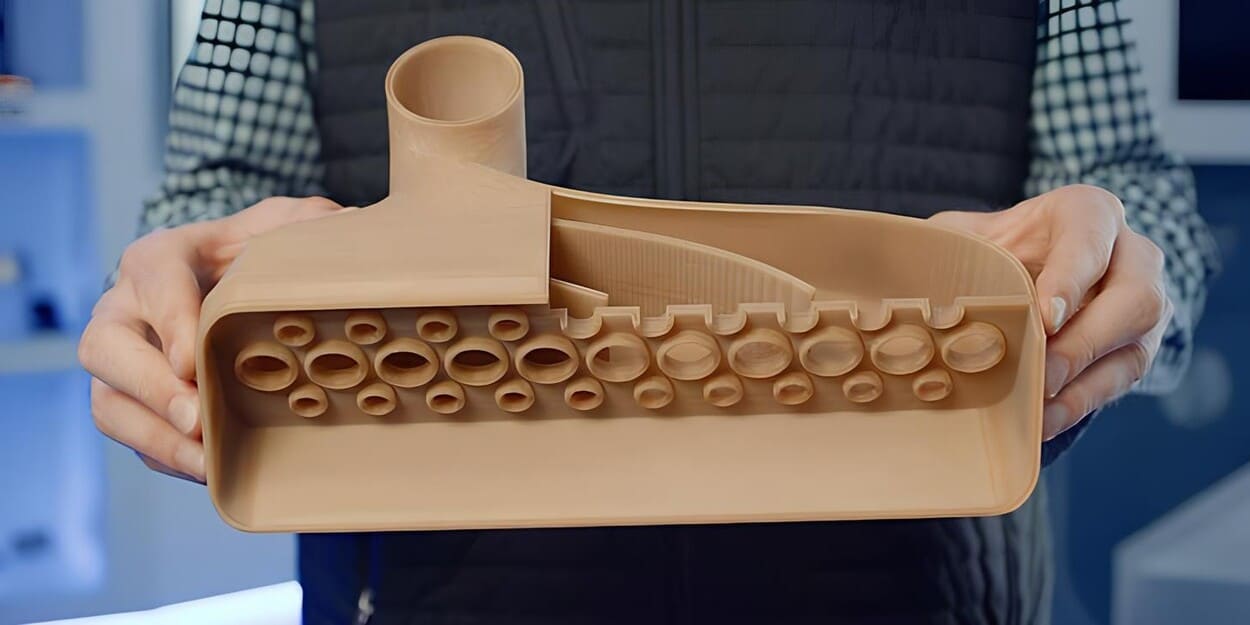Banner Image Courtesy of Stratasys
How FDM Works & Key Advantages
Fused Deposition Modeling (FDM) is one of the most widely used additive manufacturing technologies. It works by:
• Melting a thermoplastic filament through a heated nozzle.
• Depositing material layer by layer according to a digital 3D model.
• Solidifying each layer before the next is applied, creating a fully formed part.
Key Advantages:
• Cost‑effective: especially for prototypes and low‑volume runs.
• Material versatility: from standard PLA to engineering‑grade polycarbonates.
• Short lead times: functional parts can be ready within hours.
• Ease of iteration: ideal for design validation before scaling to other manufacturing methods.
Choosing the Right Material
|
Material |
Advantages |
Limitations |
Best Use Cases |
|
Easy to print, good surface finish, low warp |
Brittle, low heat resistance |
Prototypes, display models |
|
|
Strong, heat‑resistant, machinable |
Warping, requires heated bed/enclosure |
Functional prototypes, end‑use parts |
|
|
High impact resistance, minimal warp |
Slightly less rigid than PLA |
Mechanical parts, jigs & fixtures |
|
|
Excellent wear resistance, flexible |
Moisture sensitive |
Gears, hinges, moving components |
|
|
Very strong, high heat resistance |
Requires high temp & enclosure |
Industrial parts, load‑bearing components |
Wall Thickness & Feature Size Guidelines
1. Minimum wall thickness: 1.2–1.6 mm (2–3 perimeters) for durability.
2. Fine features: Avoid details smaller than 0.4 mm (typical nozzle diameter).
3. Bosses & lugs: Keep diameter ≥ 2× nozzle size to ensure layer adhesion.
4. Embossed & engraved text: At least 0.5 mm deep/high for legibility.
Layer Height, Resolution & Orientation Strategies
Layer Height
0.1 mm for high detail, smoother finish, longer print time
0.2 mm for balance of quality and speed
0.3+ mm for faster prints, reduced detail
Orientation
Strength is greatest along filament strands; orient high‑stress axes accordingly.
Surface finish improves when visible faces are oriented parallel to the build plate.
Minimize support needs by tilting or rotating parts.
Dimensional Tolerances & Fit Considerations
Due to layer bonding and thermal contraction, expect slight variations:
1. General tolerance: ±0.2 mm for most features.
2. For tight fits: Leave 0.1–0.3 mm clearance per side.
3. Consider post‑processing (drilling, sanding) for precision fits.
4. Test critical mating parts with sample prints before full production.
Support Strategy, Overhangs & Bridging
Overhangs: Keep ≤ 45° for clean results without support.
Bridging: Up to 10–20 mm gap can be spanned, depending on material and cooling.
Support Types:
1. Standard breakaway support: fast to remove, but leaves marks.
2. Soluble supports: perfect for complex geometries (PVA with PLA, HIPS with ABS).
Design Tip: Split large overhanging models into multiple parts to reduce supports and improve surface finish.
Infill, Shells & Strength Design
Shells/Perimeters: 2–4 for balanced strength and speed
Infill Patterns:
• Grid & gyroid — general strength
• Tri‑hexagonal — high rigidity
• Concentric — impact resistance
Infill Density:
• 15–25% for prototypes
• 50–100% for load‑bearing or mechanical parts
Surface Finish & Post-Processing Options
Post‑processing can dramatically improve appearance and function:
• Sanding & priming: smooths visible layer lines before painting
• Vapor smoothing (ABS/ASA): a chemical process for a glossy finish
• Filler primer & paint: good for aesthetic parts
• Epoxy coating: strengthens and seals PLA
• Machining: for tight tolerances after printing
Warping, Shrinkage & Bed Adhesion
Warping Prevention
1. Use heated beds (ABS ~100 °C, PETG ~70 °C).
2. Enclose the printer to maintain thermal stability and reduce drafts.
3. Reduce sharp corners in design — fillets distribute heat stress evenly.
Shrinkage Management
1. Account for material shrink rates in your CAD dimensions.
2. Use brims or rafts to counteract edge lift.
3. Slow the first few layers to allow better bonding between the material and the bed.
Bed Adhesion
1. Surface choice: PEI sheets, glass with glue stick, painter’s tape, BuildTak, or textured spring steel plates can all work — match the surface to your material.
2. First layer height & squish: Slightly reduce nozzle gap (≈ 0.1 mm) for better contact.
3. Bed leveling: Manual or automatic leveling ensures even adhesion across the print.
4. Adhesive aids: Glue stick, hairspray, or slurry coatings for ABS/nylon can improve hold.
5. Pre‑print cleaning: Remove dust, oils, and residue with isopropyl alcohol.
FAQs
Q: How thin can I make FDM walls without compromising strength?
A: For functional parts, stay above 1.2 mm. Decorative parts can go down to 0.8 mm with proper orientation.
Q: Can I avoid supports completely?
A: With clever design, yes. Use angles <45°, add chamfers, and split models into parts.
Q: How accurate is FDM compared to CNC?
A: FDM is generally ±0.2 mm; CNC can achieve ±0.05 mm. Hybrid workflows are common when high precision is critical.
Q: What’s the strongest infill pattern?
A: Gyroid or 100% rectilinear, but also consider more shells for outer strength.
Q: How to choose between PLA and PETG?
A: PLA is stiffer, better for aesthetics. PETG is more impact‑resistant and better in humid environments.














